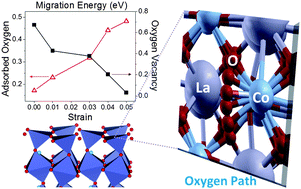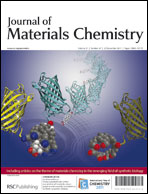Enhanced one dimensional mobility of oxygen on strained LaCoO3(001) surface
Abstract
Mechanisms by which lattice strain alters the oxygen reduction reaction (ORR) kinetics are important to understand in order to increase the ORR activity of solid ![[1 with combining macron]](https://www.rsc.org/images/entities/char_0031_0304.gif) 0] direction and a suppressed mobility along the [110] direction. The increase of space around Co that the oxygen (vacancy) traverses with a curved path is the cause of the enhanced mobility along the [1
0] direction and a suppressed mobility along the [110] direction. The increase of space around Co that the oxygen (vacancy) traverses with a curved path is the cause of the enhanced mobility along the [1![[1 with combining macron]](https://www.rsc.org/images/entities/char_0031_0304.gif) 0]. The increasing octahedral distortions with planar tensile strain inhibit the migration of oxygen vacancy along the [110] direction. Furthermore, the mobility of the adsorbed oxygen atom is suppressed with increasing strain due to its stronger
0]. The increasing octahedral distortions with planar tensile strain inhibit the migration of oxygen vacancy along the [110] direction. Furthermore, the mobility of the adsorbed oxygen atom is suppressed with increasing strain due to its stronger


 Please wait while we load your content...
Please wait while we load your content...